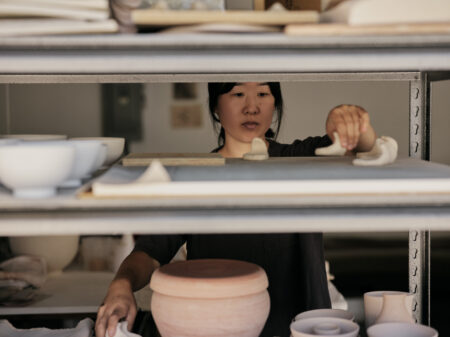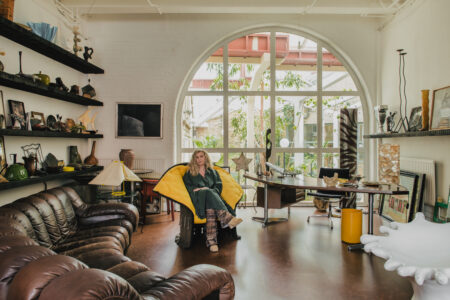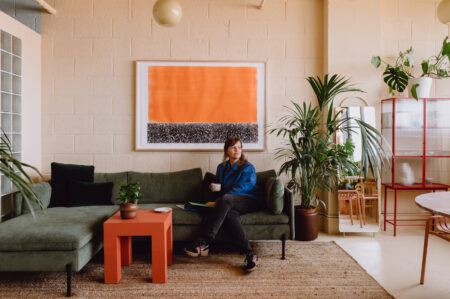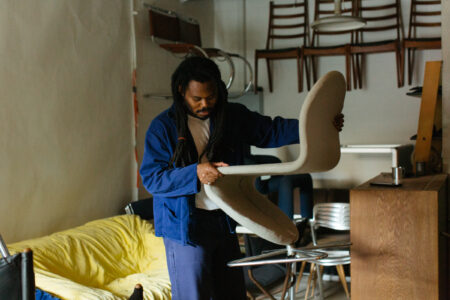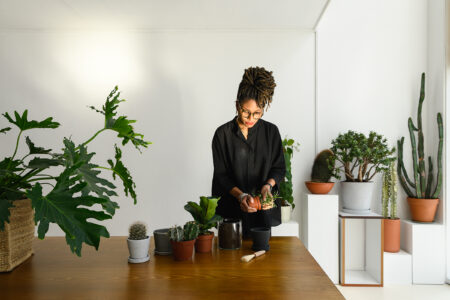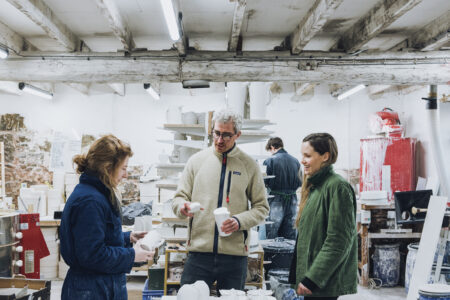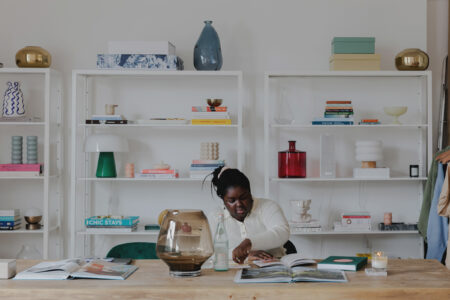Studio Visits: Lucy Attwood talks through the joys, craft and history of ceramics at Studio Pottery London

Lucy Attwood teamed up with her ceramics tutor, Gregory Tingay – a former Benedictine monk turned master potter – to launch Studio Pottery London in 2019 as a place to teach, exhibit and make ceramics in London’s Belgravia. With a background in art sales at Christie’s, Lucy has drawn on her previous experience to establish the studio’s offering, which includes works for sale, regular talks, classes for all levels and a membership service for serious potters.
Here, we explore the space that was conceived by FLINT design studio as a flexible, functional scheme inspired by Japanese aesthetics, and talk to Lucy about the joys, craft and history of ceramics.

Lucy: “When I worked at Christie’s, I was always very conscious of ceramicists such as Bernard Leach, Lucie Rie and Hans Coper, whose work was appearing in the post-war contemporary sale category, and I fell in love with them. I suppose that’s when I first heard about the great studio potters of the 20th century”.
“My introduction to making pottery was through some painting restorers known to me at Mason’s Yard. They were going to classes with someone called Gregory in north London. They loved him and his teaching and formed friendships, inviting him to their weddings and even asking him to officiate for one!
“That is Gregory Tingay, now the creative director of Studio Pottery. After about two years of plucking up the courage, I joined in on Monday nights and got hooked. I found it really helped me to relax, especially when working a 24/7 job at Christie’s. I really enjoyed the conversations I had with Gregory, who taught us not only the craft but also the history of studio pottery, and helped me experience its therapeutic dimension.



“I always thought that my work and my life should somehow merge and I knew I wanted to be incredibly passionate about what I did. So when the opportunity to launch Studio Pottery in central London came up – the only studio of its kind here – I was really excited.
“The community element is the most important part of it for me: the fact that everyone who comes here supports each other, shares knowledge and exchanges ideas.
“I think it was lovely that when Edmund de Waal opened the studio in September 2019, he referred to it as being a bit like the Bauhaus, where people with a shared love of clay and desire to make share a beautifully designed space and form a community. I find that really enriching, especially in a city like London, where people can find themselves so isolated from each other.
“We worked with design studio FLINT on the format, resulting in fantastic interiors. The scheme caters for the functional needs of teaching and practising ceramics, while the Japanese-inspired aesthetics contribute an added beauty in the display of work by high-calibre ceramicists.


“I think having a retail element at the front of the studio – where pieces on sale occupy the big window displays and entrance vitrine – challenges the studio’s community towards excellence, inspiring questions about ceramic form and surface.
“I also think people know they’ve entered somewhere a little bit special when they walk in. It was all done with such attention, from the new woodwork to the reclaimed boards used for the shelves, found at Ardinley Antiques Fair from a former pottery studio in Stoke-on-Trent: 30 years old, full of character, adding a wonderful texture and a warm tone to the studio.
“I feel like I’m preserving a little bit of history when I engage with pottery. I collect pots myself, and I feel connected with the maker of each piece I have because I know that part of their soul has gone into each pot. I very much like the romance of that.
“Coming from Christie’s, I have a profound appreciation for ancient skills and craft. I love provenance and am fascinated to know what kind of society created some of the pots that have survived. I have a piece of pottery from 750 BC which I look at every day and think, ‘What kind of person was painting on terracotta like that then, and what were they thinking?’ An artefact can tell you so much about how a society lived.



“You can learn so much from history, and I feel connected to that history when I’m making pottery. But it is also a contemporary practice and needs to evolve to stay relevant. So we have presentations in the studio to broaden knowledge of present developments, whether they be on modern glazes made from industrial waste or someone coming in talking about their studio-build in Japan.
“It’s really easy for people to get involved. We have taster sessions for people who want to try something new, or courses for those wanting to develop further. And for those who take it even more seriously our memberships gives access, materials, practice hours and more.
“We’re busier than ever, which is great. I feel like a lot of people have had time to reflect on their priorities this year, and they’ve slowed down in a way that simply wasn’t possible before. And they’ve come back to us with even more purpose and focus, which in itself is a blessing – we’re very grateful to our community for that.”







